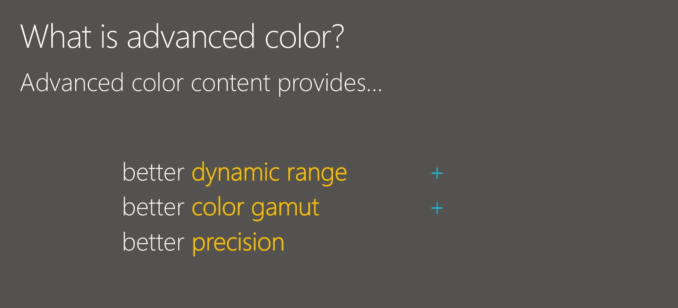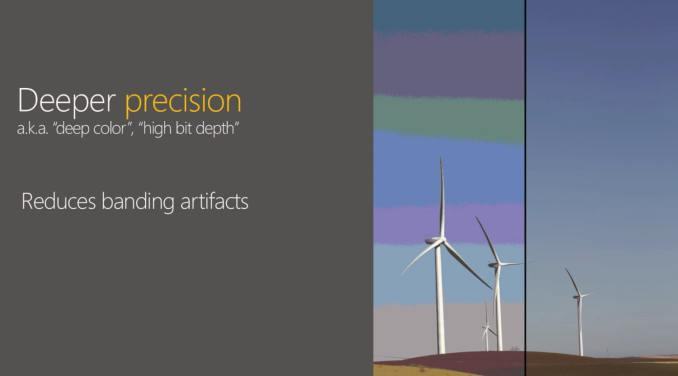The Microsoft Build 2017 Recap: What To Expect When You’re Expecting Windows
by Brett Howse on May 19, 2017 8:00 AM ESTHDR and Wide Color Gamut Support
Windows has never had a color management system to speak of, although individual developers could create their own. That did happen, but it was generally reserved for applications for media creation from companies like Adobe. With the increase in wide color gamut (WCG) devices, we’ve had some concern that this is going to continue to be an issue going forward.
Luckily this is a problem that Microsoft has been aware of for some time, and wider color gamuts, along with the introduction of high dynamic range (HDR) on televisions and displays are pressuring them to come up with a solution sooner than later. Luckily, they have made some progress here, and we were able to discuss this with Kam VedBrat, Partner Group Program Manager, and Simon Tao, Program Manager II from Microsoft to get their take on where they are at now, and where they are going.
Simon Tao has a presentation on Channel 9, and if you’re interested in this, check out his video here.
First off, we discussed where Microsoft is at now with HDR and WCG support, and their first step into this realm was actually with the Xbox One S, which launched in mid-2016. With the more constrained environment, they were able to add in new display capabilities with a known hardware pipeline. This allowed them to work closely with their content providers as well to enable HDR support in their apps. When you think about it, this makes a lot of sense, and it’s a great advantage to now have the Xbox running Windows 10 so they can use it for specific use cases like this.
Kam and Simon also discussed how the new Windows development cycle is a much better process for them, because adding HDR and WCG support into Windows is a huge undertaking. In the old method of Windows updates every couple of years, they would have been forced to add most or all of their code in one round, and if you had missed your timeline, that could mean a long wait until Windows was updated again. With the new servicing model though, they can be much more staggered in their approach, adding code that is ready now, and then learning from that code running on real machines to guide changes and adjustments for the next wave.
Creators Update actually shipped the first steps towards a high color aware OS, although it is limited to certain hardware configurations at the moment. That shouldn’t be a huge issue though, since there aren’t a lot of HDR monitors on the market yet.
With the Creators Update, Windows now has the ability to remap sRGB content into FP16 half-floats, which can then be tone-mapped from FP16 to lower precision for the final output depending on the displays capabilities. This also includes luminance which is important with HDR displays that can high much higher levels of brightness. HDR is not to make everything brighter, but to improve highlights and created a wider range of brightness levels from absolute black to the highest brightness.
For now, this is mainly being targeted towards game developers so they can use the hardware to its maximum potential, and have their product fulfill their artistic goals. But with the Creators Update, other capabilities are already available, including the media pipeline.
Right now, the onus is on the developer to bring these ideas to market, and to worry about the correct tone mapping based on the display attached to the PC, but the long term goal is to make this available to more developers, or hopefully to even have Windows handle much of this on its own. Having this available in a limited form right now though lets the team get valuable feedback from not just users, but developers as well, to see where they need to make changes. There’s still a long way to go for this to be fully implemented, but with Windows being updated twice per year now, there will be lots of chances to see this evolve and come to life.













85 Comments
View All Comments
nathanddrews - Friday, May 19, 2017 - link
"Creators Update actually shipped the first steps towards a high color aware OS, although it is limited to certain hardware configurations at the moment. That shouldn’t be a huge issue though, since there aren’t a lot of HDR monitors on the market yet."Monitor manufacturers have really, really dropped the ball. Most new 4K TVs come with 10-bit 4:4:4 4K HDR support or at least 10-14-bit 4:2:0 HDR support. DisplayPort 1.3/1.44 has been a total failure compared to HDMI 2.0 and HDMI 2.1 is going to leapfrog DP once again with features and product support.
etamin - Friday, May 19, 2017 - link
so still no adobeRGB support ffsqlum - Friday, May 19, 2017 - link
I would like it to be viable to get uwp apps from other stores than the windows store. Sure a lot of programs are not suitable for uwp but if they are I would like to use them. I just don't want to deal with a single gatekeeper that can deny apps from landing in the store they don't like. Emulators are a good example of that.ahamling27 - Friday, May 19, 2017 - link
Windows App Store does need a ton of work. It's the part of Windows 10 I try to stay away from the most.dumbnub - Friday, May 19, 2017 - link
I used the Windows app store once. I logged in with my email account, that has a 100 charatcher long password (it's so long because I use lastpass, so I thought why not?). By doing so windows now demanded I enter my 100 charatcher password in at login, whereas before I didn't use a password and of course I couldn't use lastpass at the login screen on my windows machine so I had to use my phone. It sure did make me feel like an idiot but there are lots of use out there imo. So, since I like the idea of a long password, I just don't use the app store. There maybe a very simple solution, like just making a separate email for logging in or an option in windows. But I never gave one crap about the windows app store, I was just new to windows 10 and thought it would be cool to download a free car racing game. /end of boring story.ahamling27 - Friday, May 19, 2017 - link
That really sucks and it really shouldn't have to work like that. I did remove my login password and used a local account, you may look into that, as it's not tied to your MS account.Meteor2 - Saturday, May 20, 2017 - link
Yeah, when you login to the App Store you're using you're 'Microsoft account', which then becomes your Windows user account. It's vaguely useful if you have multiple machines and Office 365, but not for a lot else. It's also the same as/can be used as a hotmail account, I think.Macpoedel - Saturday, May 20, 2017 - link
There are alternatives that replace the password section once you set up your account with password, although they are less secure. In Windows 10 you can set up a pincode, an image "password" on which you have to draw a chosen pattern or you can set up a biometric verification with Windows Hello (facial recognition or fingerprint matching).To be clear, your password remains the same as before, it's just for the login procedure and for entering administrative rights that the above methods replace your password.
This has been around since Windows 8.
Ionestly, I set my desktop up to not require a password, it's not going anywhere. And I also have a Windows 10 HTPC, having to enter a password there would be incredibly annoying. But my laptop needs to be protected of course.
Kevin G - Friday, May 19, 2017 - link
What I want are Microsoft products that actually work to the point where I spend more time being productive than fighting the tools themselves. Case in point, Outlook not only crashes randomly, but I'll go into various states of uselessness. Try quick reply from the preview pane? Ha, I'll be typing but my text will not appear. Pop out the reply from the preview pane and the text I was typing magically appears! Want to view a calendar? Ha, it'll randomly display a blank white screen. Outlook will also screw up the scroll bars in calendar view so that they bars themselves will move but the actual content will not. This is even worse when view more than one calendar. It feels like I'm running head first repeatedly into a brick wall using Outlook. It is actually more productive for me to use my phone for quick emails and view calendar items than Outlook now.Excel is just slow. I swear for basic calculations an older 1 Ghz box from ~17 years ago running Office 98 felt faster than Excel does now on a modern quad core 3.0 Ghz system. Oh, and the new function Excel is introducing don't necessarily adhere conventional syntax used previously in Excel.
Word has this chronic disease that it can't handle white space in an intelligent fashion. Delete a block of text? Guess what, that block of text's formatting will live on in the white space around it make any attempt to type a new block of text in its place a formatting nightmare. There is a reason why I've adapted to doing quick typing in NotePad and then pasting it in when it comes time to formatting. Outlook to a lesser extent has this same problem. Spreading like herpes.
PowerPoint has regressed by wanting to alter my monitor arrangement every time I attempt a slide show. It says it remembers my settings so that I don't have to rearrange everything after a presentation (or before or during) but I've seen more honest used car salesmen.
Dynamics integration in Outlook is painful to use due to its backwards interface. The web version isn't any better.
Windows 10 also like to reboot at the most inopportune time for me: generally when I'm doing work. Also it likes to lie to me sometime when I would like to reboot later if I put my laptop to sleep. So if I want to delay the reboot by four hours and I put my laptop to sleep overnight for ~8 hours, it'll ask me again when I wake it up but then realize that I woke it up after the initial 4 hour mark and reboot anyway. Nothing like waking up to a reboot punching you in the face in the morning.
dumbnub - Friday, May 19, 2017 - link
I bought a second-hand Lenovo that came with windows 8 pre-installed and got the free upgrade to 10. I decided, stupidly, to roll it back to 8. While rolling back there was an error and I was left with no functioning OS. A family member of mine is an accountant who did use excel exclusively but it would randomly freeze when more than one excel tab was open. They use Zoho now and a chromebook even though Zoho, being completely online, isn't ideal due to slows downs every now and again.